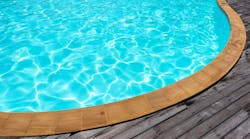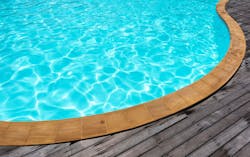This is a traditionally busy time of year for pool projects, as pool owners have maintenance done or do upgrades just before “swimming weather.” New installations also get wired about this time.
Work on spas gets a seasonal boost even though fitness centers typically locate their spas and similar “tubs of water” indoors. Folks want to look better in their swimsuits as they head to those pools, and the spa is often part of the “get fit quick” regimen.
This can mean booking a few too many jobs at once, and thus having pressure to work more quickly. Or it can mean taking on lucrative new work as potentially new customers find your company and offer up some jobs you really aren’t that experienced in doing. All this creates a “Code-violation-likely” environment.
But with a little preparation and diligence, you can avoid common Code violations in your pool and spa work, even with the seasonal pressure. For starters, make sure your project specifications reflect the fact that Chapters One through Four apply to all of these installations, except as modified by Art. 680.
Grounding
The grounding of pools and spas is an area where confusion often occurs. Let’s look at an example of this confusion and how it was fixed.
A duplex condominium resident owned a hot tub. The installer grounded it, and considered it safe. But was it? An electrician found that the ground rod violated 250.52. But why was it even there?
The hot tub is on the load side of the service. A ground rod does not create an equipotential plane, so the water in the tub was still at a different potential from the 120V supply to the pump motor and controls — nor did the rod provide a low-impedance path back to the service panel. Therefore, a significant portion of any undesired current would simply flow through the motor bearings and through the tub and any occupants therein.
Part of the implemented solution was to bond the hot tub rod to the service panel ground rod, using a 4 AWG bare conductor buried at 18 in. This basically made use of the additional rod plus added a long electrode (the 4 AWG conductor).
Then the electrician pulled a 10 AWG insulated grounding conductor from the pool panel through the raceway to the service panel and connected to one of the panel’s ground lugs. This properly bonded the equipment to the EGC.
The earth is a high-impedance path back to the source. Connecting the equipment to a driven ground really does nothing to protect the people who enter the pool, spa, or similar “tub” of water. Keep this in mind when “grounding” this equipment.
In fact, you really are required to bond it to the equipment grounding conductor (EGC). You find this requirement throughout Art. 680. Wherever there is equipment, you don’t connect it to a ground rod and consider that a sufficient path back to the source. Instead, you must use an EGC to create a low-impedance path back to the source. Note that the EGC terminates at the equipment grounding terminal of the panelboard — not to a ground rod.
Finally, make sure the entire system of grounding and bonding conforms to Parts V, VI, and VII of Art. 250. In 680.6., you’ll find an enumerated list of seven types of equipment that must be “grounded” (bonded).
Related
What if some item isn’t on that list? Do you still bond it? Yes, because you want the installation to be safe. The NEC is not a design guide; it merely provides the minimums for safety and the Code Making Panel members can’t think of every possible variation. If in doubt, always apply the principles behind the NEC requirements.
Drainage
The customer has a little equipment shed near the pool. It sits on a flat slab. It’s plenty dry in there, so you don’t think of the drainage requirement [680.11]. This is where he wants it installed, so he must have made the appropriate provisions, right?
As anyone who’s worked with pool equipment knows, connections come apart, and things leak. It doesn’t matter if the room is dry now. What matters is whether it has drainage so the inevitably leaked water doesn’t accumulate.
The NEC says “during normal operation or filter maintenance,” but it does not say that filter hoses will never come off during normal maintenance. In fact, that’s the one time during which they are most likely to do so. Pool equipment rooms are not generally noted for being roomy and easy to work in.
Maintenance
All of the utilization equipment other than lighting requires at least one local disconnect for maintenance [680.12]. Each disconnect must be readily accessible and within sight of the equipment it disconnects. That means, for example, you can’t install one of these disconnects inside the equipment shed unless it’s for the equipment in that shed.
It also must be at least 5 ft from the water’s edge (inside wall of the “tub”) unless a permanent barrier separates it from the water and provides a reach path of at least 5 ft.
Nowhere in 680.12 does it say this disconnect must be lockable in the open position. But suppose it’s a public pool, and maintenance is probably going to be done during operating hours.
Normally, the equipment shed door is locked to prevent access by unauthorized personnel, such as curious nine-year-old boys. The maintenance contractor will probably leave that open when sauntering out to the service van for a part he needs. So he comes back to resume work and doesn’t notice the handle is now up instead of down. Simply anticipating such a danger and installing a lockable disconnect would have prevented a tragedy and several lawsuits.
Always assess the particular installation for possible dangers the NEC doesn’t specifically address. If you’ve already bid on the job and there’s an extra cost, explain the safety and liability issues to the owner.
Beyond the general
Thus far, we’ve looked only at Part I of Art. 680 (plus addressed some Art. 250 requirements). Each of the other Parts pertains to a particular type of tub of water (see Which Part Covers What? on page C6).
We don’t have space here to go through each Part (II through VII) to identify and discuss a “critical code requirement.” But we can identify four common threads. Knowing those will help you quickly spot some of the common code violations (such as convenience receptacles being a little too conveniently located near the pool). These are:
1. All of the equipment must be listed for that particular use.
2. Receptacles within a certain distance (fairly short) must be GFCI-protected.
3. The luminaire requirements (where applicable), while different in their specifics, pretty much boil down to using a luminaire suitable for the installation and making sure it’s properly bonded.
4. Switches must be at least 5 ft from the water.
Therapeutic pools and tubs
As the median age continues to increase (the “graying of America”), the need for physical therapy also continues to increase. Pools and tubs are used for all kinds of therapy, and the demand is on the rise.
For example, the number of Americans with adult onset diabetes has increased about tenfold over the past 30 years. Impaired circulation from diabetes can cause tissue death, followed by amputation of the affected parts. Because these pools and tubs improve circulation (even if only temporarily), they are increasingly part of the prevention arsenal.
You install one of these and dutifully connect all the green wires to grounding terminals. So is there more? Yes. More than half of Part VI is about bonding and grounding these units and the related equipment.
It’s not just those wires; it’s also the metal table that’s 4 ft away. The requirement is to bond any metallic surface that’s within 5 ft [680.62(B)(4)]. That 5-ft distance is yet another of those common threads.
Lamendola is an electrical consultant located in Merriam, Kan. He can be reached at [email protected].
SIDEBAR: Which Part Covers What?
Each of the final six Parts of Art. 680 provides requirements for a specific type of tub of water:
Part II. Permanently installed pools.
Part III. Storable pools (plus storable spas and hot tubs).
Part IV. Spas and hot tubs (storable or not).
Part V. Fountains.
Part VI. Therapeutic tubs.
Part VII. Hydromassage tubs.
Keep in mind that each of these Parts has the same basic goals (keep electricity, people, and water away from each other), so common threads exist between these Parts though specific requirements vary.





